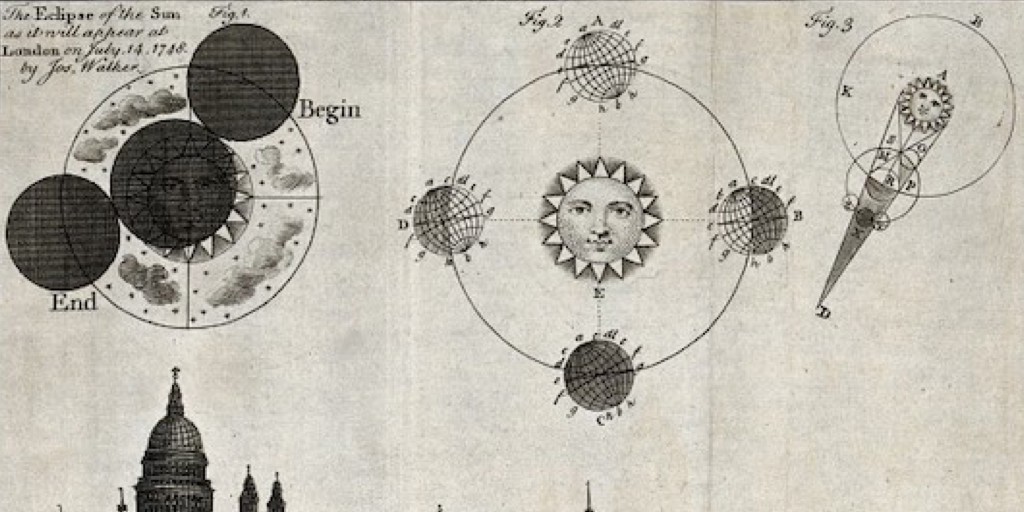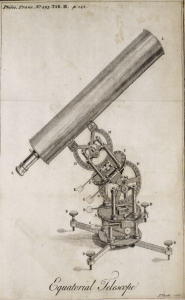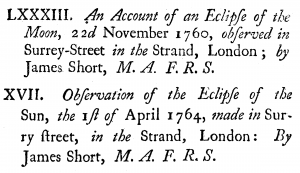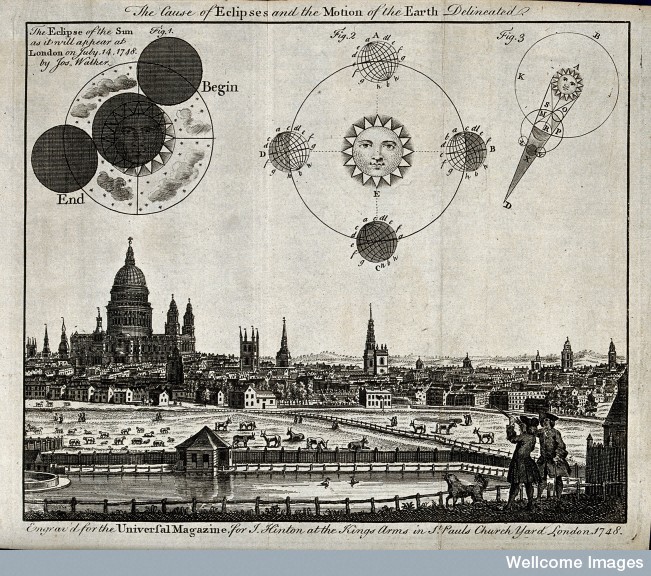Stargazing from centuries gone by
Posted in 1700-1799, 18th Century, people, Places, Strandlines, streets and roads and tagged with astronomy, History, history of science, London, observations, Royal Society, science, scientific, star gazing, strand, telescope, telescopes, universe, Westminster

In the 18th century, the Philosophical Transactions journal (then a relatively new publication) preserved several accounts of astronomical events as observed from the Strand. The Royal Society of London provided James Short, “from the College at Edinburgh”, this platform to publish his observations.
In the Philosophical Transactions database Short’s name appears thirty-four times. Of these, fourteen are either observations from his Surrey Street home or letters written from this address. A further six report observations from friends’ homes on Fleet Street. One reports using Marlborough House, down the Mall, as an observatory.
Who is James Short?
James Short is both a symbol of London and Britain in this period. His central position in London in his Surrey Street home situates him in a long legacy of notable peoples along the Strand. A Scottish astronomer and mathematician, he entered the University of Edinburgh in 1726. He only settled in London permanently in 1739. This is a particularity of London-living, to this day, the duality of origins for many Londoners.

Equatorial telescope as drawn by James Short in 1750.
Moreover, Short’s life intersected with British colonialism leading to the presence of non-British sites in his work. The clearest examples of this are his astronomical observations from the Cape of Good Hope published in January 1761.
He was also an inventor, constructing new equipment such as the equatorial telescope (a telescope mounted in a way that allows it to stay fixed on any celestial object despite movements of both earth and bodies in space).
In a letter to the President of the Royal Society in 1750, he states “I have made three of these instruments, one of which was bought by Count Bentink for the Prince of Orange; the other two I have still by me, one of which I shall show to the Society.” This is important because it shows the wealth of some of Short’s patrons. As such we can explain the large wealth – 20,000 pounds – that Short had accumulated before his death. Using a basic conversion website which accounts for inflation, this is roughly 3.4 million pounds in 2020. Clearly James Short was an extremely successful astronomer.
Short and the Strand
James Short was based in Surrey Street, after becoming a fellow of the Royal Society of London in 1737. Some of his observations were made from his home, just off the Strand. For example, on the 22nd of November 1760 he recorded a lunar eclipse from Surrey Street, and he even included details such as the starting time (7:39) and ending time (10:09).
Similarly, one can look at the 1st of April 1764 when he observed a solar eclipse from the Strand. In this instance he was joined by “the Earl of Morton, now President of this Society” and both used separate equipment to make their observations. Short specified that he used a “smoked-glass” lens to “defend my eye” from the sun during his observations.
From these accounts we can reimagine the weather from 260 years ago, and many of his observations are rather poetic:
“The conditions of the air was very unpromising, for, besides a general haziness of the sky, thin slow moving clouds were frequently passing over the Sun.”
Through James Short we can get a glimpse of the life of a Royal Society member in the 18th century. These pieces of London history are just waiting to be explored in the Society’s archives. These letters and observations, though sometimes rather over-full of scientific jargon, are fascinating to read. The accounts are both a looking-glass into the past of our city, and astronomical phenomena simultaneously, glimpsing the 18th-century streets below and the universe above.

The Chapter Titles in Philosophical Transactions of the 1760 Lunar Eclipse and 1764 Solar Eclipse observed by James Short.
Sources:
https://royalsocietypublishing.org/action/doSearch?ContribAuthorStored=Short%2C+James&startPage=0&pageSize=20
https://en.wikisource.org/wiki/Short,_James_(DNB00)
https://www.in2013dollars.com/uk/inflation/1768?amount=20000
https://www.open.edu/openlearn/history-the-arts/history/history-science-technology-and-medicine/history-science/how-did-18th-century-people-react-eclipses


Very interesting thank you!